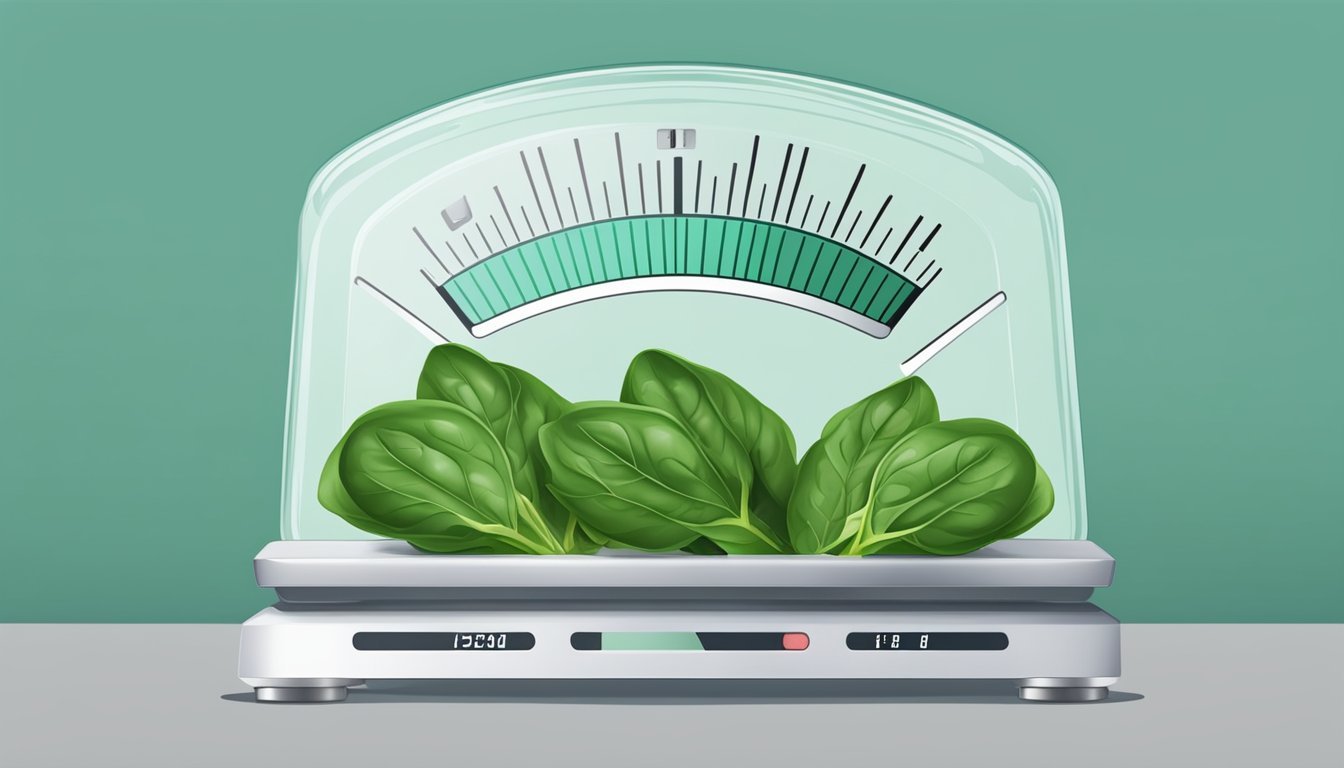Frozen Spinach vs Fresh: Weight Conversion Guide for Recipes
Spinach is a versatile and nutritious leafy green that can be found in both fresh and frozen forms. Many home cooks and chefs find themselves wondering about the differences between these two options, particularly when it comes to weight and usage in recipes.
When substituting frozen spinach for fresh, a good rule of thumb is that 10 ounces of frozen spinach equals about 1 pound of fresh spinach. This conversion is useful for adapting recipes and ensuring the right amount of spinach is used in dishes. The weight difference is due to the water content in fresh spinach, which is reduced during the freezing process.
Both frozen and fresh spinach offer similar nutritional benefits, providing essential vitamins, minerals, and antioxidants. The choice between the two often comes down to convenience, texture preferences, and specific recipe requirements. Fresh spinach offers a crisp texture ideal for salads, while frozen spinach works well in cooked dishes and is readily available year-round.
Nutritional Comparison
Frozen and fresh spinach offer similar nutritional profiles, but some key differences exist in their vitamin, mineral, and caloric content. These variations can impact dietary choices and cooking methods.
Vitamin and Mineral Content
Frozen spinach retains most of its nutrients during the freezing process. It contains comparable levels of vitamin A, vitamin K, and potassium to fresh spinach. Frozen spinach often has higher iron content than fresh due to concentration during processing.
Fresh spinach provides more folate, a crucial B vitamin. It also contains higher levels of vitamin C, which can degrade during freezing and storage. Beta-carotene, an antioxidant that converts to vitamin A in the body, is more abundant in fresh spinach.
Both forms offer significant amounts of calcium and other minerals. The freezing process can make some nutrients more bioavailable, potentially enhancing the absorption of certain compounds.
Caloric and Weight Differences
Fresh spinach has a higher water content, resulting in a lower calorie count per serving compared to frozen spinach. A cup of raw spinach typically contains about 7 calories, while a cup of frozen spinach has around 30-40 calories.
Frozen spinach is more concentrated due to water loss during processing. This means a smaller volume of frozen spinach can provide equivalent nutrients to a larger amount of fresh spinach. When cooking, 1 cup of frozen spinach is roughly equal to 4 cups of fresh spinach in terms of volume and nutritional content.
Weight-wise, frozen spinach is denser. This can be advantageous for recipes requiring larger quantities of spinach, as less frozen spinach is needed to achieve the same nutritional value as fresh.
Storage and Shelf Life
Proper storage techniques and understanding shelf life are crucial for maintaining the quality of both frozen and fresh spinach. Effective freezing methods and preservation practices can significantly extend spinach's usability.
Freezing and Thawing Techniques
To freeze fresh spinach, blanch it briefly in boiling water, then plunge into ice water. Drain thoroughly and pat dry to remove excess moisture. Place spinach in freezer-safe bags, removing as much air as possible.
Frozen spinach packages can be stored in the freezer for up to 6 months. When ready to use, thaw in the refrigerator overnight or use the defrost setting on a microwave.
For best results, avoid refreezing thawed spinach as it can lead to texture changes and potential quality loss.
Preserving Quality
Fresh spinach typically lasts 3-5 days in the refrigerator when stored properly. Wrap it in paper towels to absorb excess moisture and place in a plastic bag with small holes for air circulation.
Frozen spinach maintains its nutritional value and color better than fresh spinach over time. However, it may lose some texture during the freezing process.
To preserve quality, store frozen spinach at 0°F (-18°C) or below. Avoid storing it in the freezer door where temperature fluctuations occur.
Use frozen spinach within 6 months for optimal flavor and texture. After thawing, consume within 1-2 days for best quality.
Preparation and Cooking
Frozen and fresh spinach require different approaches for optimal preparation and cooking. The methods used can impact texture, flavor, and nutrient retention.
Pre-cooking Preparation
Fresh spinach needs thorough washing to remove dirt and debris. Rinse leaves in cold water and dry with paper towels or a salad spinner. Remove tough stems and tear large leaves into smaller pieces. A sharp knife on a cutting board works well for chopping.
Frozen spinach requires thawing before use. Place the package in the refrigerator overnight or use the microwave for quicker results. Once thawed, squeeze out excess liquid using a colander or clean kitchen towel. This prevents watery dishes.
Cooking Strategies
Fresh spinach wilts quickly when heated. It's ideal for quick sautés, stir-fries, or adding raw to salads. Blanching fresh spinach briefly in boiling water preserves its bright green color and reduces bitterness.
Frozen spinach works well in cooked dishes like stews, casseroles, and pasta sauces. It's pre-blanched, so it only needs reheating. Add it directly to soups or stir into dishes near the end of cooking time.
Both types can be steamed or microwaved. Fresh spinach takes 1-2 minutes, while frozen may need 3-5 minutes. Avoid overcooking to maintain nutrients and texture.
Usage in Recipes
Frozen and fresh spinach can be used differently in recipes, impacting flavor, texture, and cooking methods. Their unique properties affect how they're incorporated as main ingredients or substitutes.
As a Primary Ingredient
Frozen spinach works well in cooked dishes like casseroles, pasta sauces, and cream spinach. Its compact nature makes it easy to measure and add in precise amounts. When using frozen spinach, thaw and squeeze out excess water before incorporating. This prevents dishes from becoming watery.
Fresh spinach is ideal for salads, smoothies, and lightly cooked dishes. It adds a vibrant green color and crisp texture. In cooked recipes, fresh spinach wilts significantly, reducing in volume by about 90%. Use larger quantities of fresh spinach to achieve the same volume as frozen.
As a Substitute
Substituting frozen spinach for fresh, or vice versa, requires adjustments in quantity and preparation. Generally, 10 ounces of frozen spinach equals 1 pound of fresh spinach in cooked recipes. When substituting fresh for frozen, use 1 pound of fresh spinach for every 10-ounce package of frozen called for in the recipe.
For raw applications, frozen spinach cannot directly substitute fresh. In cooked dishes, frozen spinach may alter texture slightly but provides similar nutritional benefits. When using fresh spinach as a substitute in recipes calling for frozen, cook and drain it first to remove excess moisture.
Additional Considerations
When comparing frozen and fresh spinach, several factors beyond nutritional content come into play. These include economic aspects, culinary applications, and potential health implications.
Economic and Culinary Factors
Frozen spinach often proves more cost-effective than its fresh counterpart, especially when spinach is out of season. It has a longer shelf life, reducing food waste and saving money in the long run.
Culinary applications vary between the two forms. Fresh spinach excels in salads and sandwiches, providing a crisp texture and mild flavor. Frozen spinach, pre-blanched and chopped, is ideal for cooked dishes like dips, casseroles, and pasta sauces.
For convenience, frozen spinach is hard to beat. It's pre-washed, chopped, and ready to use, saving time in meal preparation.
Health Implications
Both forms of spinach offer significant health benefits. The American Heart Association recommends regular consumption of leafy greens like spinach to reduce the risk of heart disease.
A study from Pennsylvania State University found that frozen spinach retains its nutrients well, sometimes even better than fresh spinach that's been stored for several days.
Frozen spinach may contain slightly less folate than fresh, but the difference is minimal in a balanced diet. Both forms provide essential vitamins, minerals, and antioxidants that support overall health.



